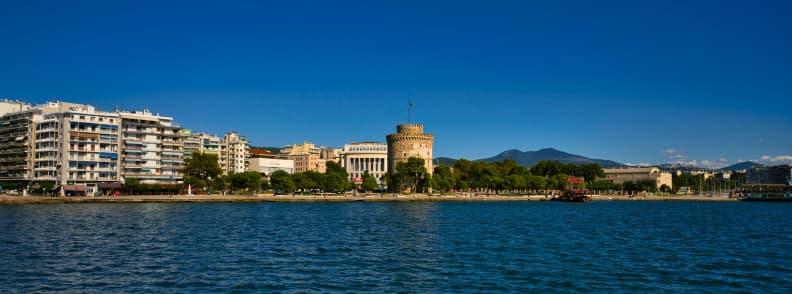Most people skip Thessaloniki. I almost did too.
I’d planned a few days in Athens, then a flight straight to an island. Thessaloniki was supposed to be a stopover. One night, maybe two. A buffer between places that “mattered”.
But something made me pause. A friend was speaking about what to do in Thessaloniki and mentioned the food. Someone else said the street life reminded them of Istanbul. I looked at a map and saw how close it was to the Balkans, to Turkey, to history that rarely makes it into beach-brochure Greece. So I booked three nights. I stayed five. And I could’ve easily stayed more.
What to do in Thessaloniki Greece
If you’re into old cities that feel lived-in, into places where ruins and record shops sit on the same street, where your best meal might come from a bakery with no sign, then this city’s for you.
If you travel for food, for markets, for local rhythms, and for the kind of chaos you can’t script, this city rewards you.
It’s not dressed up for tourists. And that’s what makes it such a great place to explore.
Why Thessaloniki is Worth Visiting
There’s no Acropolis. No island beaches. No Mamma Mia churches. And yet this city completely got under my skin. It’s walkable, scruffy, layered, loud, welcoming, full of good smells and odd corners. You don’t need to try hard to “find” the real Thessaloniki. It’s just there.
Let’s start with what stood out immediately.
1. It’s a city that lives in its streets
Everything happens outside in Thessaloniki. People drink coffee slowly, smoke aggressively, talk with their hands, and linger for hour. Not because they’re lazy, but because that’s just how life works here. Time moves differently.
On my first morning, I walked down to Navarinou Square to get my bearings. It’s not a “sight”, just a scrappy plaza with ancient ruins in the middle. Students were sitting on the Roman stones, drinking takeaway coffee. A man walked past selling koulouri from a basket. Behind me, someone was playing the clarinet. There were no big tour groups. Just life, happening.
That’s what Thessaloniki does best. It gives you space to be in a place, instead of performing your way through it.
2. It’s small enough to walk, big enough to get lost
The historic center hugs the seafront. You can cross it in 20–30 minutes. But don’t. It’s not made for rushing. I spent whole mornings just walking from Kamara to Ladadika, getting sidetracked by bookshops, hidden courtyards, and old pastry shops.
There’s something surreal about passing a Roman arch, and then seeing it reflected in a Zara window. Or standing in front of a 14th-century Byzantine church wedged between a pharmacy and an electronics store. You’re always moving through time.
I remember walking uphill toward Ano Poli Thessaloniki one afternoon and realizing I hadn’t taken a photo in over an hour. Not because there wasn’t anything to shoot but because I was too absorbed to take out my phone.
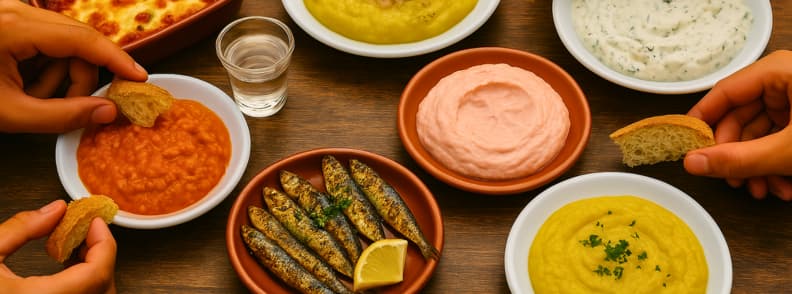
3. The food is ridiculous, and nobody brags about it
Every city in Greece will tell you they have the best food. Thessaloniki might actually be right and yet no one here seems too fussed about convincing you.
What makes it different is the refugee influence, especially from Asia Minor (modern-day Turkey), but also from Armenia, Pontus, and the Balkans. In 1922, after the Greco-Turkish war, over a million Greeks were forced to flee from Anatolia. Thousands of them came here. They brought their recipes.
That’s why you’ll see dishes here that don’t show up much elsewhere in Greece like lahmacun, soutzoukakia smyrneika, patsas, bougatsa with semolina cream, even spicy muhammara dips. The food is bolder, spicier, messier… and cheaper.
I had one of the best meals of the trip inside Modiano Market, at a little place where the waitress sat down to explain every dish to me. I ended up with vine leaves stuffed with rice and cinnamon, a glass of local red wine, and grilled cheese with hot pepper jam. Total cost? Just under €12.
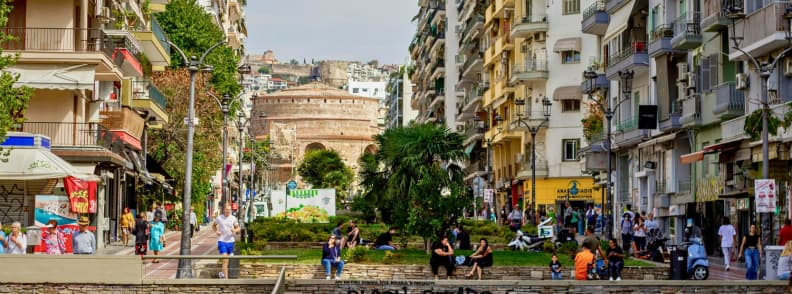
4. It’s full of layers, not landmarks
The more I walked, the more I noticed this city doesn’t really give you wow sights. Not in the typical way. There’s no single postcard view. Instead, you get layers. Roman, Byzantine, Ottoman, Jewish, Balkan, and modern Greek, all living on top of each other.
In one block, I saw a mosque, a synagogue, two churches, and a tattoo studio. No signs explaining anything. You’re expected to look. To ask questions.
Even the city’s symbol, the White Tower, is kind of modest. It used to be a prison. Now it’s a museum. It’s not stunning from the outside, but climb to the top and you’ll get one of the best views in Greece. Sea on one side. Terracotta rooftops on the other. And the constant noise of life below you.
5. The people are blunt, funny, and kind once you crack them
Thessalonians are a mix. Some are old-school and stiff, others are warm and hilarious. But almost everyone I met had an opinion, a story, or a recommendation.
At a café in Ano Poli, I asked the waiter if they had decaf. He frowned and said, “We have real coffee. You’re young. Drink that.” Then he brought me a double and a biscuit “on the house”. Later, when I tried to pay, he waved me off and said, “Just come back when you’re tired again.”
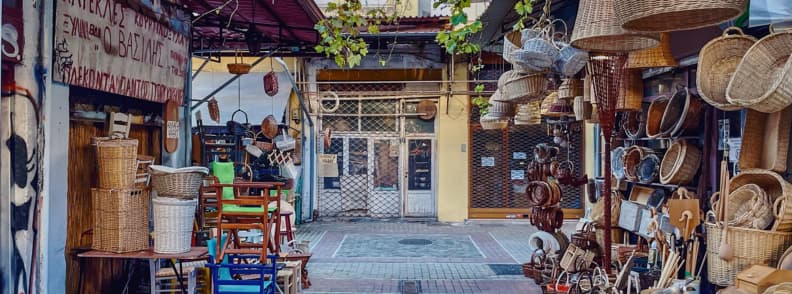
What Most Travel Guides Miss (And What to Do Instead)
If you search “what to do in Thessaloniki”, you’ll get a familiar list:
- White Tower
- Rotunda
- Archaeological Museum
- Byzantine Museum
- Church of Agios Dimitrios
- A meze place in Ladadika
- A walk on the promenade
Then what?
Nothing. End of itinerary. Back on the train to Athens or a quick flight to Santorini.
That’s the problem with most guides. They treat Thessaloniki like a warm-up act. A city to get through before the main event.
I think that’s a mistake.
Because what makes Thessaloniki special doesn’t always fit into a list. It’s in the back alleys, in the smell of roasting sesame seeds, in the half-conversations you overhear from a bus stop. It’s a feeling. And that’s hard to list but easy to feel if you give it time.
Here’s where I think most visitors get it wrong and what I’d suggest you do instead.
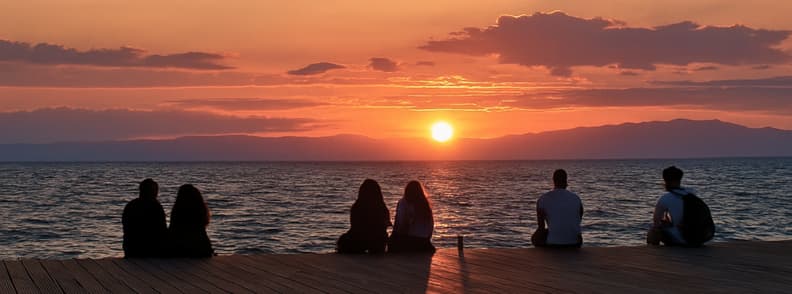
Mistake #1: Rushing It
Two days is not enough. One night is pointless. Thessaloniki isn’t for speed. The real version of this city unfolds slowly across meals, coffees, walks, and conversations. It doesn’t reveal itself to people checking boxes.
I met a woman at the Rotunda who said she was doing “all the sights” in half a day. I asked what she was planning for lunch and she said she’d “just grab something”. That’s like going to Naples and skipping the pizza.
Better idea? Treat this like a weekend city. Like Lisbon. Or Palermo. Somewhere you come to walk, eat, and hang out. Not to collect monuments.
Mistake #2: Sticking to Ladadika
Ladadika is fine. It’s where most visitors end up eating. And honestly, some of the food there is good, especially at Full Tou Meze and Rouga. But it’s a polished version of the city. Renovated. Branded. Slightly overpriced.
If you want a local lunch experience, skip Ladadika and go east to Bit Bazaar or deeper into the Valaoritou area. I had one of the best meze spreads of my trip in a tiny place called To Kouti. No sign, just an open kitchen and a few tables spilling onto the pavement.
Even better? The Ano Poli ouzeris, especially during daylight hours. I found one run by two brothers who used to be fishermen. They served homemade tsipouro in recycled soda bottles and grilled sardines with lemon and oregano. No menu. No Instagram. No English. Just good food, loud locals, and a lot of laughs.
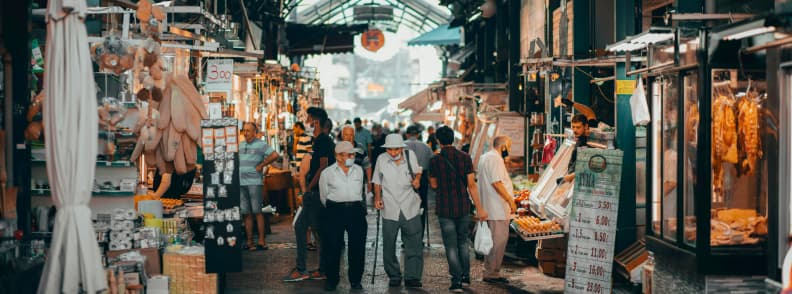
Mistake #3: Ignoring the Markets
Every time I visit a new city, I go straight to the market. It tells you everything: what people eat, how they talk, what they value. In Thessaloniki, the central market zone is wild.
There’s Kapani (the oldest), Modiano Market Thessaloniki (recently renovated), and Vlali (chaotic in the best way). Each has its own energy. Walk through at 10 AM and you’ll see butchers shouting, old women haggling over cheese, students buying koulouri for breakfast.
I spent two hours one morning just wandering the stalls. Bought olives from a man who looked like he hadn’t blinked since 1982. Had bougatsa and Greek coffee standing up at a bakery window. Ended up chatting with a spice vendor about the right way to make soutzoukakia.
This isn’t the kind of thing you’ll find in a guidebook but it tells you everything about the place you’re in.
Mistake #4: Skipping the Jewish Quarter
This is one of the most important, and most overlooked, parts of Thessaloniki’s history.
Before WWII, Thessaloniki was a Jewish city. That’s not poetic license, it’s a fact. For centuries, it was home to one of the largest Sephardic Jewish communities in the world. In the 1930s, nearly 60% of the city’s population was Jewish.
And then came the Nazi occupation. In 1943, 96% of that community was deported and murdered. It’s one of the most devastating and least talked about Holocaust stories in Europe.
Today, you can still trace some of that history. The Jewish Museum of Thessaloniki is small but powerful. There are plaques on buildings that used to be synagogues or community centers. The old Jewish cemetery, once one of the largest in the world, was destroyed and paved over. Parts of the Aristotle University now sit on it.
None of this is light. But it’s worth knowing. It’s part of the city’s DNA and it makes the present-day version of Thessaloniki even more complex.
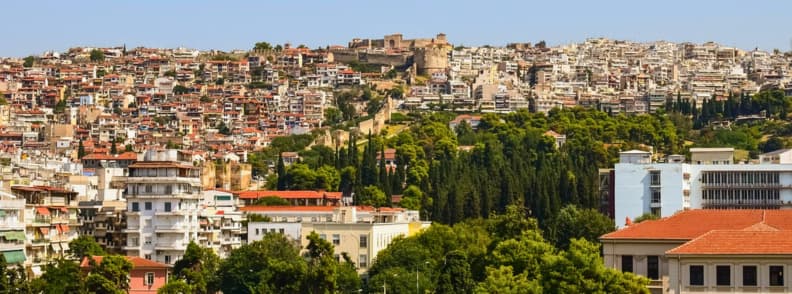
Mistake #5: Avoiding the Hills
Yes, Ano Poli is steep. Yes, you’ll sweat. But this part of the city, the Upper Town, is what survived the great fire of 1917. The rest of the city was rebuilt with a modern grid, but Ano Poli kept its maze.
It’s quieter up there. More village-like. Cats sun themselves on terracotta roofs. Church bells ring from stone towers. It smells like woodsmoke and jasmine.
I took a detour one afternoon and ended up at the Trigonion Tower, part of the old Byzantine walls. The view over the city is unreal with rooftops tumbling down to the sea. I stayed there for an hour just watching the light change.
There’s no entrance fee. No queue. No café. Just a wall and a view. That’s Thessaloniki at its best.
So What Should You Actually Do?
This is where my 3-Day Thessaloniki Itinerary comes in.
I made this for people like me. People who travel to feel a city, not just see it. People who like getting a bit lost, who follow smells into bakeries, who ask for the house wine and end up making friends.
Here’s what the guide gives you:
- 3 slow travel days with minimal backtracking
- A mix of culture, food, street life, and views
- Actual restaurant names, but only ones I went to and liked
- Map links, walking routes, and practical tips for each section
- Personal notes about how I planned each day (and where I changed my mind)
This isn’t a cookie-cutter itinerary. It’s the one I used. The one I’d recommend to a friend.

🎁 Get the Thessaloniki Weekend Guide
Want the full version?
🧳 Click here to download my 3-Day Thessaloniki Itinerary →
It includes:
- Half-day routes for each neighborhood
- Where to go for the best views, the best coffee, the best meze
- A complete day in Ano Poli (without collapsing)
- Notes on what not to waste your time on
- Budget tips and alternative options
And yes, it’s printable. Because sometimes it’s nice to have something you don’t need Wi-Fi for.
🎁 Or Start with the Freebie
Not ready to grab the full guide?
Here’s a free teaser: a three-page printable with 5 Common Mistakes in Thessaloniki AND How to Avoid Them. No fluff, just five real experiences with my personal notes.
🧷 Download the Free Guide Here →
Great if you’re in a rush but still want to avoid the basic stuff.
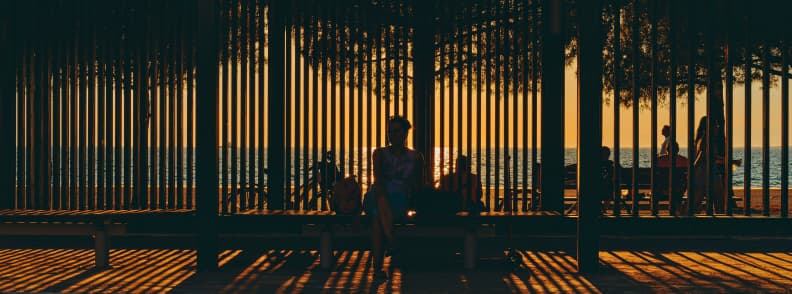
How I Spent My First 3 Days in Thessaloniki (& Why I Stayed Longer)
When I first arrived, I didn’t plan much. Just a few pinned spots and three nights booked. I thought I’d do the usual: see the White Tower, eat something good, move on.
Instead, this is how my first three days actually unfolded:
- I spent hours in Navarinou Square, watching people argue over politics and frappé.
- I got lost in Ano Poli and found a courtyard church with frescoes no one talks about.
- I ate grilled sardines at a taverna with plastic chairs and a tiny kitchen run by two brothers who used to fish for a living.
- I walked through markets that smelled like cinnamon and bleach and wet concrete.
- I had coffee with strangers. I drank tsipouro before noon. I watched the light change over the sea every single night.
By the end of day three, I knew I wasn’t leaving yet.
I extended my stay. No plans. Just mornings that started with bougatsa and afternoons shaped by mood: museum or market, walk or ouzeri.
And that’s when the city really opened up. Once I stopped trying to see it and just let it carry me.
Final Tips for Slow Travel in Thessaloniki
- Don’t plan too much. I know it’s tempting, but leave space for detours. The best parts of this city aren’t the “top sights.” They’re the old man who pulls out a chair for you. The bakery you smell before you see. The back alley leads somewhere better than Google Maps could guess.
- Skip the open-top bus. You’ll see more on foot and hear more, too.
- Get cash. Cards are accepted, but many smaller places, especially markets and ouzeris, prefer cash.
- Eat late. Locals don’t sit down for dinner before 9 PM. Join them.
- Say yes. To the third glass of tsipouro. To the fried cheese. To the old woman offering you homemade pickles. Thessaloniki is generous. Let it be.
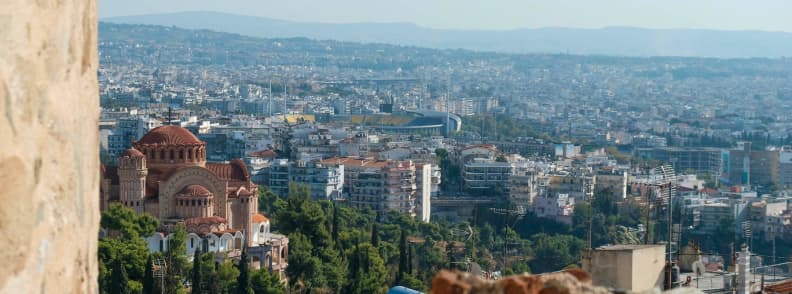
Why Thessaloniki Is the Best City in Greece to Slow Down
I didn’t come to Thessaloniki expecting to love it. It wasn’t on my must-see list. But it showed me something I didn’t even know I was craving: a city that doesn’t care if you’re impressed. One that’s not selling itself. One that just is.
If you like culture you can touch, food that makes you forget what time it is, and streets that reward wandering, then you’ll probably feel the same.
Want the Itinerary in Your Pocket?
Download the 3-Day Thessaloniki Weekend Guide:
- Walkable routes
- Hidden corners
- Local tips
- No fluff
Just Curious? Grab the Free Guide
If you’re still deciding, download my 3-page printable:
5 Common Mistakes in Thessaloniki AND How to Avoid Them
About the Author

Hi, I’m Mirela Letailleur, a Romanian-born travel writer based in the South of France, and the voice behind The Travel Bunny. I create no-fluff, slow-travel guides for culture lovers, food seekers, and curious travellers who’d rather wander backstreets than follow tour groups.
I don’t write about “must-see” lists. I write about places the way I experience them through markets, conversations, quiet corners, and local meals that stay with you longer than any postcard view.
Over the last few years, I’ve explored Greece deeply, including Thessaloniki. My Thessaloniki weekend guide was built from real days spent walking, eating, talking, and learning the city’s rhythm. It’s part itinerary, part local food guide, and part travel philosophy.
If you’re looking for Thessaloniki foodie tips, cultural spots that don’t feel staged, or slow travel Greece experiences that help you connect with place, then you’re in the right spot.
If you enjoyed finding out what to do in Thessaloniki Greece, check out these travel articles
Visit Athens: Your Ultimate Travel Guide
Secrets of Athens: Discover 10 Best Hidden Gems in the Greek Capital
Visit to Piraeus: One Amazing Day That Transformed Our Lives

